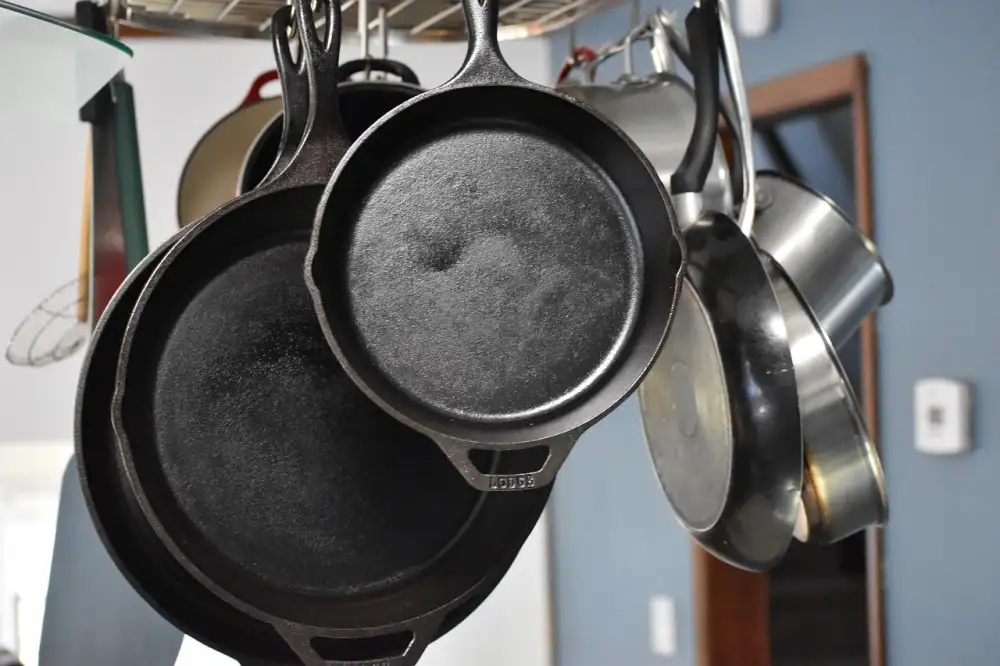Revive Your Rusty Cast Iron Skillet: A Step-by-Step Guide to Restoring its Shine

A rusty cast iron skillet can be a real eyesore in your kitchen, but don't worry, with a little bit of effort and the right techniques, you can restore its shine and bring it back to life. Cleaning a rusty cast iron skillet may seem daunting, but it's actually quite simple if you follow the proper steps. In this guide, we will take you through each step of the process, from gathering the necessary materials to drying and seasoning the skillet. So let's dive in and revive your rusty cast iron skillet!
Gather the necessary materials for cleaning
To revive your rusty cast iron skillet, you'll need a few essential materials. First and foremost, gather a stiff-bristled brush or scrub pad to remove the rust. Next, grab some mild dish soap and warm water for cleaning. You'll also need white vinegar or lemon juice to help dissolve the rust. Additionally, have some coarse salt on hand for scrubbing away stubborn spots. Finally, make sure to grab a clean cloth or paper towels for drying the skillet and a neutral cooking oil for seasoning it afterward. With these materials in place, you're ready to restore your cast iron skillet's shine!
Preparing the cast iron skillet for cleaning
Before diving into the process of cleaning your rusty cast iron skillet, it is essential to prepare it properly. Start by removing any loose debris or food particles from the surface. Use a stiff brush or a plastic scraper to gently scrape off any stuck-on residue.
Next, fill your sink with warm water and add a few drops of mild dish soap. Place the skillet in the soapy water and let it soak for about 10-15 minutes. This will help loosen any remaining dirt or grease.
After soaking, use a sponge or cloth to scrub the skillet thoroughly. Avoid using abrasive materials as they can damage the seasoning on the skillet. Pay extra attention to areas with stubborn rust spots.
Once you have scrubbed away all visible dirt and rust, rinse the skillet under running water to remove any soap residue. Make sure to dry it thoroughly using a clean towel or by placing it over low heat on your stovetop.
Now that your cast iron skillet is prepared for cleaning, you are ready to move on to the next step: scrubbing away the rust.
Scrubbing away the rust
Scrubbing away the rust is an essential step in restoring your rusty cast iron skillet. To begin, use a stiff brush or steel wool to vigorously scrub the surface of the skillet. This will help remove any loose rust particles and dirt. Make sure to scrub all sides of the skillet, including the handle and bottom. Apply some elbow grease to ensure a thorough cleaning. Remember not to use soap at this stage as it can strip away the skillet's seasoning. Rinse the skillet with warm water to remove any remaining debris.
Removing stubborn rust spots
Removing stubborn rust spots can be a bit more challenging, but with the right techniques, your cast iron skillet will be shining in no time. One effective method is to create a paste using equal parts baking soda and water. Apply the paste to the rust spots and let it sit for about 15 minutes. Then, use a scrub brush or steel wool to gently scrub away the rust. Rinse the skillet thoroughly and inspect for any remaining rust. If needed, repeat the process until all the rust is gone. Remember to always dry your skillet completely after cleaning to prevent future rust formation.
Drying and seasoning the skillet
Once you have thoroughly cleaned your rusty cast iron skillet, it is important to ensure that it is completely dry before proceeding to the next step. Any moisture left on the skillet can lead to rust formation again.
To dry the skillet, use a clean cloth or paper towels to remove any excess water. Make sure to pay extra attention to the corners and crevices where water may accumulate.
Next, place the skillet on a stovetop burner set on low heat. Allow the skillet to heat up gradually for a few minutes. This will help evaporate any remaining moisture and ensure that the skillet is completely dry.
Once the skillet is dry, it's time to season it. Seasoning helps create a protective layer on the surface of the cast iron, preventing rust and enhancing its non-stick properties.
To season your skillet, apply a thin layer of vegetable oil or flaxseed oil all over its surface, including the handle. Use a paper towel or cloth to spread the oil evenly.
Preheat your oven to 350°F (175°C) and place the oiled skillet upside down on the middle rack. This allows any excess oil to drip off during seasoning.
Bake the skillet for about an hour, then turn off the oven and let it cool completely inside before removing.
Remember, seasoning is not a one-time process; it should be repeated periodically to maintain your cast iron skillet's shine and prevent rust from forming again.
By following these steps for drying and seasoning your cast iron skillet, you can revive its shine and ensure its longevity in your kitchen arsenal.
Tips for preventing rust in the future
1. Dry thoroughly: After each use, make sure to dry your cast iron skillet thoroughly. Moisture is the enemy of cast iron and can lead to rust formation. Use a clean towel or paper towel to remove any excess moisture.
2. Season regularly: Regularly seasoning your cast iron skillet creates a protective layer that helps prevent rust. After cleaning, apply a thin layer of oil to the entire surface of the skillet and bake it in the oven at a low temperature for about an hour.
3. Store properly: Store your cast iron skillet in a dry place with good air circulation. Avoid stacking other pans on top of it, as this can trap moisture and promote rust formation.
4. Avoid acidic foods: Acidic foods like tomatoes or citrus can react with the iron in the skillet and cause rusting. If you need to cook acidic foods, try using an enameled cast iron skillet instead.
5. Use gentle cleaning methods: Avoid using harsh scrub brushes or abrasive cleaners on your cast iron skillet, as these can strip away the seasoning and expose the metal to moisture.
By following these tips, you can keep your cast iron skillet looking shiny and rust-free for years to come!
In conclusion, reviving a rusty cast iron skillet is a simple process that can bring new life to your cooking experience. By following the steps outlined in this guide, you can restore your skillet's shine and ensure its longevity. Remember to gather the necessary materials, prepare the skillet properly, scrub away the rust, and remove any stubborn spots. After drying and seasoning, your skillet will be ready for use once again. To prevent future rusting, make sure to store it in a dry place and avoid soaking it in water for extended periods. With proper care, your cast iron skillet will continue to serve you well for years to come. Happy cooking!
Published: 17. 12. 2023
Category: Home



